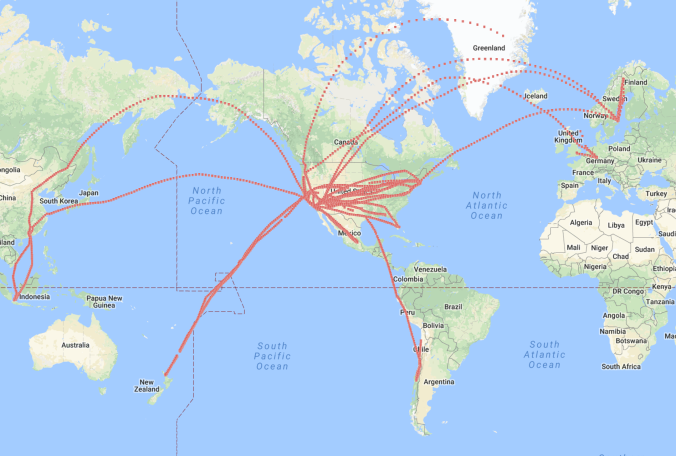Rads on a Plane: The Data

Many people think that only astronauts have to worry about cosmic radiation. Not so. Ordinary air travelers are exposed to cosmic rays, too. On a typical flight over the continental USA, radiation dose rates in economy class are more than 40 times higher than on the ground below.
Cosmic rays penetrate the walls of aircraft with ease. This has prompted the International Commission on Radiological Protection (ICRP) to classify pilots as occupational radiation workers–just like nuclear power plant engineers.
Since Jan. 2015, Spaceweather.com and the students of Earth to Sky Calculus have been monitoring cosmic rays in airplanes. Our method is simple: We board planes carrying the same cosmic ray payload we routinely fly to the stratosphere on space weather balloons. Inside the airplane we measure X-ray, gamma-ray and neutron dose rates along with GPS altitude, latitude and longitude

Above: Flight paths forming the basis of our aviation radiation study. 2015-2017
Three years after our first flight, our data set is impressive. We have 14,183 GPS-tagged radiation measurements collected during 67 flights over 2 oceans and 5 continents. We have spent 236.4 hours onboard planes taking data. If you accumulated that into a single flight, it would amount to 9.8 uninterrupted days on a plane.
This substantial data set is allowing us to explore how radiation varies with altitude around the globe. It’s not the same everywhere. The Arctic, for example, differs sharply from the equator, and there are interesting departures from “normal” near the South Atlantic Anomaly. We’re also discovering how Earth’s natural magnetism shields travelers from radiation: there’s a strong correlation in our data between dose rate and the geomagnetic field around the airplane.
Best of all, we can now predict dose rates for flights that haven’t even taken off yet. Using the data from 2015-2017, we’re building an empirical predictive model and actively testing it against new flights in 2018. Early results show that it works well over the continental USA, and we are beginning to check international flights, too.
Read more at spaceweatherarchive.com
PRINCIPIA SCIENTIFIC INTERNATIONAL, legally registered in the UK as a company  incorporated for charitable purposes. Head Office: 27 Old Gloucester Street, London WC1N 3AX. Telephone: Calls from within the UK: 020 7419 5027. International dialling: (44) 20 7419 5027.
incorporated for charitable purposes. Head Office: 27 Old Gloucester Street, London WC1N 3AX. Telephone: Calls from within the UK: 020 7419 5027. International dialling: (44) 20 7419 5027.
Please DONATE TODAY To Help Our Non-Profit Mission To Defend The Scientific Method.
Trackback from your site.

jerry krause
| #
Hi Tony,
This Earth to Sky Calculus project which involves interested high school students should be copied studying other simple, ordinary physical phenomena which established ‘science’ considers too simple (ordinary) to invest their time doing and reporting. This report of their efforts probably would not qualify for publication in Science or Nature or whatever peer-reviewed scientific journals but will probably be read by more people than most articles published in such journals and which often do not focus as actual observations (measurements)
Hopefully readers with see that the students analyzed actual data, not averaged data, to find that the intensity of cosmic radiation is not homogeneous. Which the common averaging of the earth’s measured temperatures has to produce. Even the ocean surfaces are not homogeneous as their temperatures vary with latitude and longitude and season.
I have a question for you. Could thin, nearly invisible, cirrus cloud which probably exist at altitudes above those at which the commercial planes fly influence the intensity of the cosmic radiation measured?
Have a good day, Jerry .
Reply